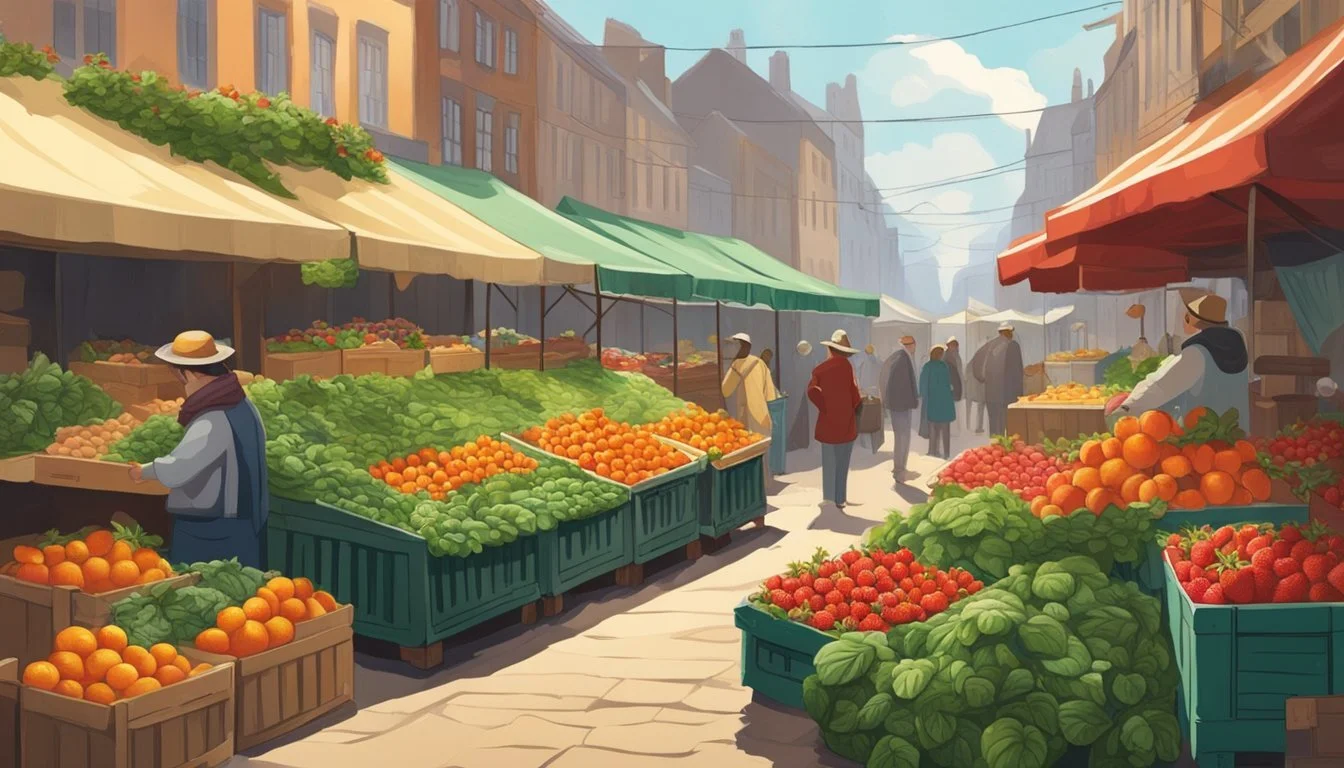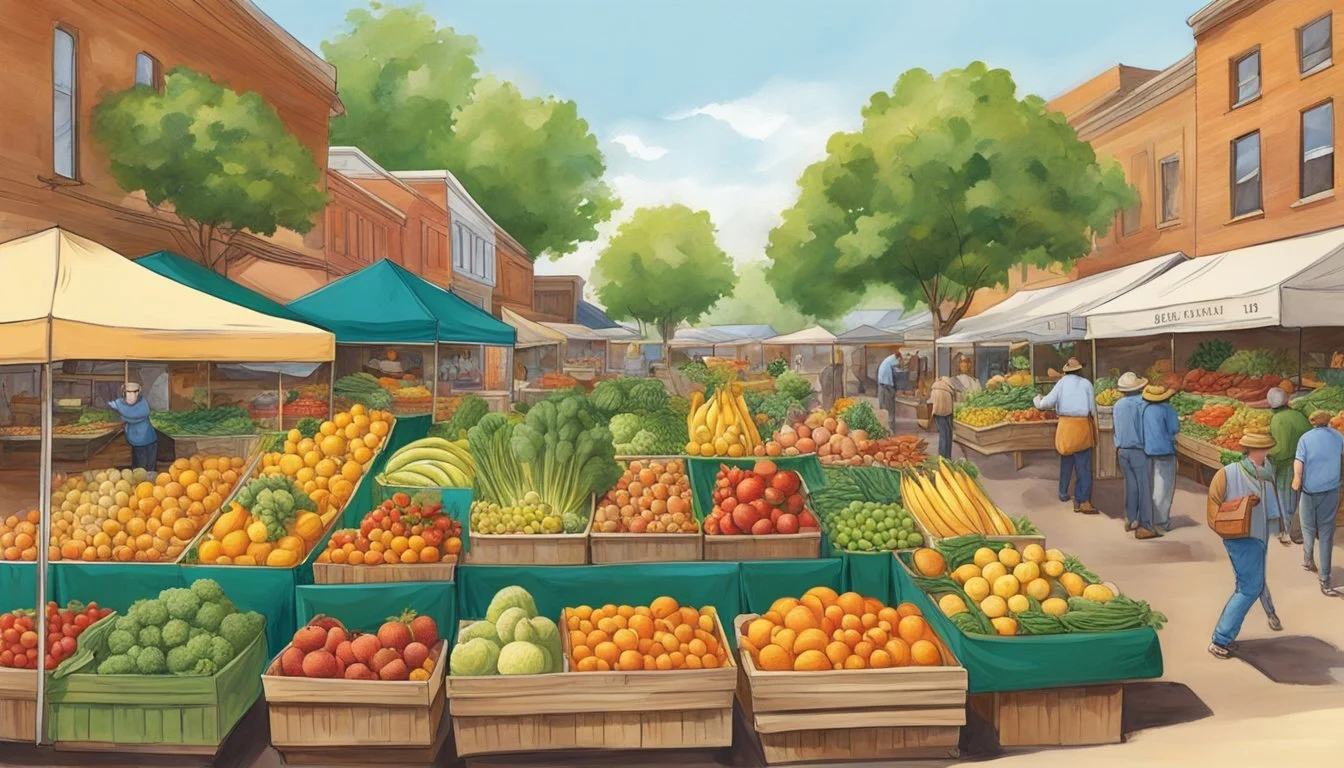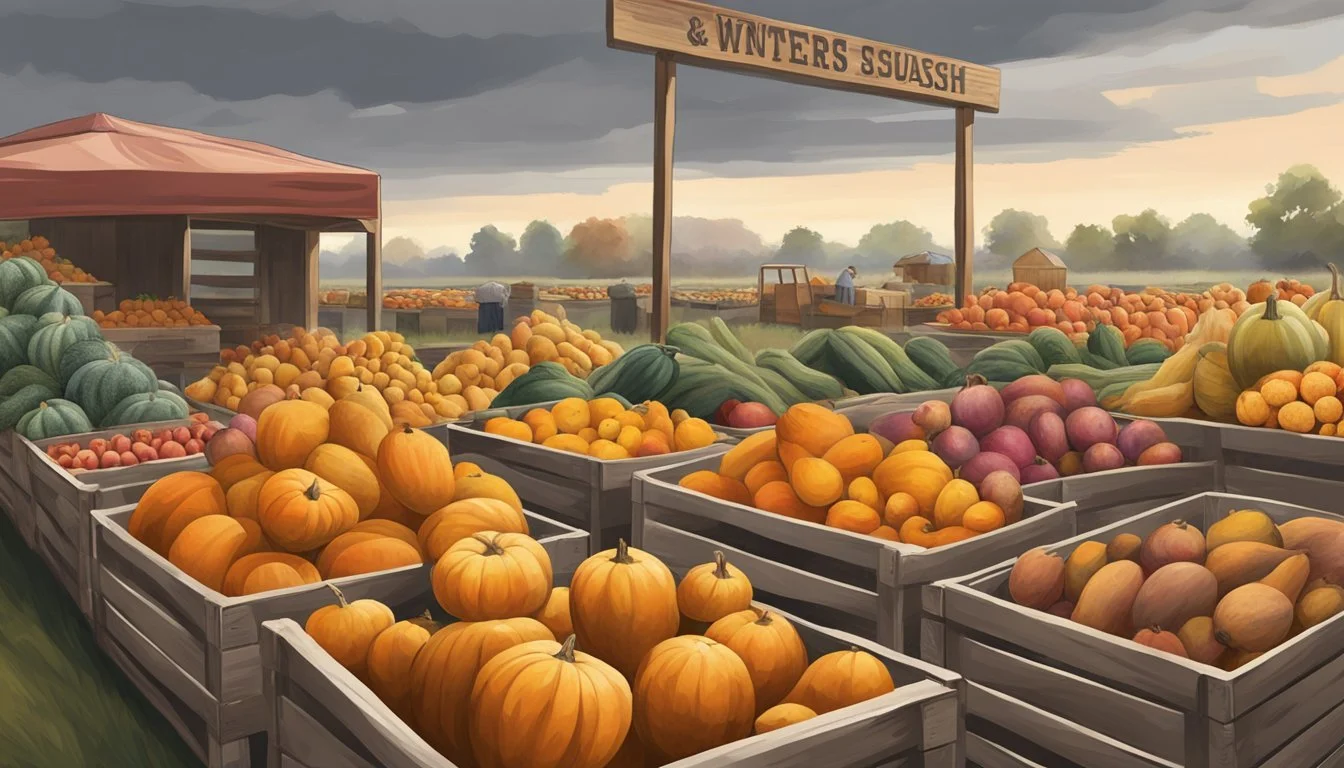Oklahoma Seasonal Fruit & Vegetables Guide in February
What's Fresh?
This Article is Part of our Oklahoma Seasonal Fruit & Veg Calendar
February in Oklahoma brings a season of transition, where the last of winter meshes with the early whispers of spring. During this period, the state's produce availability echoes the change in seasons. A variety of fruits and vegetables reach their optimal quality in the cooler months, with citrus fruits like lemons, limes, oranges, and grapefruits offering vibrant flavors and a bounty of nutrients.
In addition to citrus, Oklahoma's February harvest caters to a range of tastes with cool season vegetables. Farmers prepare the soil for planting, taking care to ensure soil temperatures are conducive for seed germination. The seasonal produce does not just promise freshness but also supports local agriculture and sustainable practices common to the region. The harvest during this month is not limited by the cooler temperatures; rather, it is a period where careful preparations set the stage for the abundance of spring.
Seasonal Highlights in February
In February, Oklahoma's seasonal harvest features a variety ripe for picking. From tangy citrus fruits to hardy root vegetables, residents have access to a variety of fresh produce despite the cooler temperatures.
Citrus Fruits
February marks the peak of citrus season, offering a bounty of Vitamin C-rich fruits. Shoppers can expect to find a diverse selection, including:
Oranges: Including navel and the more exotic blood oranges
Grapefruits: Such as the classic ruby variety
Lemons: Like the Eureka and Meyer lemons
Limes: A staple for culinary use
Green Vegetables
This month is also ideal for planting and harvesting several green vegetables that thrive in cooler weather. Gardens and markets will see:
Cabbage: A versatile green used in various dishes
Lettuce: Numerous variants are ready for fresh salads
Peas: Fresh pods brimming with sweetness
Root Vegetables
Root vegetables, packed with nutrients and flavor, are still in season:
Carrots (how long do carrots last?): Ranging from deep orange to purple and yellow
Potatoes: Available in several varieties such as russet and red
These vegetables are known for their storage capabilities and robust flavors, making them a hearty choice during winter months.
Winter Squash
Lastly, winter squash varieties continue to be available:
Butternut squash: (how long does butternut squash last?) With a sweet, nutty taste perfect for soups and roasts
Acorn squash: Its distinct ridged skin encloses slightly sweet flesh
They can be utilized in a range of dishes, adding both nutrition and a touch of winter comfort to any meal.
Healthy Eating with February Produce
In Oklahoma, the month of February offers a varied selection of produce that is both flavorful and packed with nutrients. Utilizing these fruits and vegetables can greatly benefit one's daily diet.
Nutritional Benefits
Greens: A foundation in healthy eating, greens like spinach, kale, (What wine goes well with kale?) and lettuce in February contain high levels of vitamins A, C, and K, and minerals such as iron and calcium.
Carrots: Rich in beta-carotene, which the body converts to vitamin A, carrots support good vision and a strong immune system.
Cabbage: A versatile vegetable that serves as an excellent source of vitamin C and dietary fiber, supporting digestive health.
Turnips: Often underappreciated, turnips can bolster a February diet with fiber, vitamin C, and a number of important minerals.
Apples: While not at the peak of their season, storage apples available in Oklahoma are a great source of dietary fiber and vitamin C.
Produce Nutrients Greens Vitamins A, C, K, iron, calcium Carrots Beta-carotene, fiber, vitamin K Cabbage Vitamin C, dietary fiber Turnips Fiber, vitamin C, calcium Apples Dietary fiber, vitamin C
Dietary Recommendations
Integrating a variety of these vegetables and fruits into one's diet is recommended by nutritionists. Greens should form the base of the diet due to their comprehensive nutrient profile and low calories, making them ideal for weight management and overall health. Carrots and turnips add both a sweet and earthy flavor to meals while boosting one's intake of essential vitamins.
For salads and side dishes, lettuce and cabbage provide crunch and nutrients with minimal calories. One can enhance the nutritional content of a meal by adding spinach or kale to smoothies or as a cooked side. Apples, while not in their prime, remain a healthy snack option due to their fiber content, which promotes satiety and aids in digestive health.
Growing Your Own
In February, Oklahoma gardeners can benefit significantly from planting specific vegetables and preparing their gardens against common pests. This section provides practical advice for a successful start to the growing season.
Gardening Tips
Planting in Oklahoma during February means focusing on cool-season crops, which thrive in the fluctuating temperatures that can include cooler days and chilly nights. Gardeners should refer to the USDA Hardiness Zone map, as Oklahoma spans from Zones 6 to 7b, to determine the appropriate planting schedules for their specific area.
Here's a concise table for planting in Oklahoma's February garden:
Vegetable Planting Date Range Days Until Harvest Cabbage February 15 - March 10 60 - 90 Days Carrots February 15 - March 10 70 - 80 Days Lettuce Early February 50 - 75 Days Peas Mid to Late February 60 - 70 Days Potatoes Mid to Late February 90 - 120 Days
Gardeners should start seeds indoors or in a protected area for some vegetables to safeguard against unpredictable frost. It is equally essential to ensure the soil is well-draining and to incorporate ample organic material to nourish the plants.
Pest Management
Managing pests is a critical part of gardening, particularly in the early stages of plant growth. Gardeners should be watchful for signs of pests such as deer, rabbits, and squirrels, which can be attracted to tender shoots and leaves.
Deer: Installing fencing that is at least 8 feet tall can deter deer as they are less likely to jump barriers that are high and difficult to see through.
Rabbits: A fence buried at least 6 inches below the soil can prevent rabbits from digging underneath. Keeping the garden clean of refuse can reduce hiding spots for rabbits.
Squirrels: Use wire mesh or netting to protect plants, especially young seedlings, from squirrels. Employing squirrel deterrents or decoys can also be effective.
Consistent monitoring and early intervention are key. Gardeners may use a combination of methods, from mechanical barriers to approved repellents, to protect their plants from these common garden pests.
Oklahoma's February Produce Selection
In February, Oklahoma gardens yield a variety of root vegetables and leafy greens, thriving in the cooler temperatures of the season.
Root Vegetables: Oklahoma's soil gives rise to several hearty root vegetables during February. Carrots and potatoes are prime for harvest and offer versatility in the kitchen. Turnips and parsnips, less common but equally nutritious, can also be found in local markets, providing a sweet, earthy flavor to winter dishes. Onions and leeks, indispensable for adding depth to soups and stews, are readily available.
Leafy Greens: Leafy greens, cherished for their nutrients and ease of cooking, flourish in the colder months. Spinach and kale emerge as favorites due to their high vitamin content and culinary flexibility. Lettuce varieties are ready for harvest, inviting fresh salads despite the chilly weather. Cabbage, with its robust structure, is perfect for creating comforting winter meals.
Winter Squabbles: Winter squash, encompassing varieties like butternut and acorn, stay in season, contributing sweetness and texture to hearty meals. Their thick skins allow for extended storage, making them a staple throughout the season.
Celery, although less highlighted, remains a kitchen essential for flavoring and garnishing many winter recipes.
A February garden in Oklahoma offers a bounty that is both nutritious and flavorful, inviting chefs and home cooks to explore the state's seasonal offerings. With the right preparation, these vegetables can serve as the foundation for countless warming meals during the last stretch of winter.
Farm to Table: Recipes and Uses
Oklahoma’s February harvest brims with hearty vegetables and limited fruit selections, offering a spectrum of flavors for both straightforward and complex recipes.
Simple Preparations
Simple dishes often accentuate the natural flavors of seasonal produce. A side dish like roasted root vegetables is not only easy to prepare but also nutritionally rich. One can enjoy carrots and sweet potatoes with a slight drizzle of local honey and a sprinkle of cinnamon, baked until they caramelized to perfection.
For a refreshing salad, mix crisp greens such as arugula or spinach with thinly sliced radishes and segments of winter-available grapefruit. Toss with a simple vinaigrette made from local vinegar and Oklahoma’s own pecan oil for a dish that is as nutritious as it is flavorful.
Complex Dishes
On the complex side, the vegetables and fruits available can transform into heartier, comforting stews and soups. For instance, butternut squash and sweet potatoes can be the base for a rich, velvety soup, enhanced with spices like nutmeg (how long does nutmeg last?) and cumin, then puréed until smooth.
Desserts that feature deeper flavors are ideal in the colder month of February. A sweet potato and pecan pie, sweetened with molasses and spiced with cinnamon and ginger, can bring warmth and satisfaction to the end of any meal.
When it comes to drinks, one might not find an abundance of fruit in Oklahoma in February, but that doesn't mean one can't enjoy a delicious fruit-based beverage. A smoothie made with frozen summer berries, local apple cider, and a dollop of honey is both invigorating and nutritious, providing a taste of seasons past and to come.
Preservation and Storage
Proper storage techniques ensure the longevity and quality of fresh produce. Specific methods vary according to each type of fruit or vegetable, allowing consumers to enjoy the seasonal bounty for longer periods.
Short-Term Storage
Citrus: Citrus fruits such as oranges and lemons should be stored at room temperature away from direct sunlight for several days. For storage up to a couple of weeks, they can be refrigerated in mesh bags or loose in the crisper.
Apples: Keep apples in a cool place or in the refrigerator. To prevent them from absorbing strong odors, store them in a plastic bag with holes for airflow.
Kale: Store kale in the refrigerator, wrapped in a damp paper towel, and placed inside an airtight bag. It typically stays fresh for about a week.
Turnips: Turnips can be stored in the refrigerator for up to two weeks. They should be placed in a perforated plastic bag in the crisper drawer.
Long-Term Preservation
Citrus: Citrus can be preserved through canning, drying, or freezing. For example, lemons can be juiced and frozen, and oranges can be segmented and canned.
Apples: Apples can be preserved by canning, making into applesauce, or drying. Sliced apples can be frozen on a tray before transferring to airtight containers.
Kale: For long-term preservation, kale can be blanched and frozen, or dried and crumbled into dishes such as soups.
Turnips: To preserve turnips for several months, they can be blanched and frozen or pickled.
Shopping for Seasonal Produce
When February arrives in Oklahoma, consumers seeking fresh produce are inclined to focus on both local markets for the freshest selections and supermarket offerings that provide a wider range.
Local Markets
Local markets in Oklahoma are the ideal spots for sourcing the freshest seasonal produce. Patrons can typically find a variety of citrus fruits which are at their peak during this month. Here, one may encounter fruit varieties such as:
Blood oranges
Grapefruits
Moreover, local markets are treasured for offering fresh greens that could include spinach and kale, depending on the weather and local growing practices. Root vegetables like beets and carrots are also commonly found and are celebrated for their earthy flavors and nutritional value.
Supermarket Selection
Supermarkets in Oklahoma tend to have a broader selection of produce, albeit not always locally sourced. During February, shoppers can expect to find both fruit and veggies that are not necessarily in season locally, but are available due to national and international supply chains. Seasonal produce in the supermarket often includes:
Lemons
Limes
Oranges
Additionally, supermarkets may offer other veggie options, though the freshness and sourcing may vary compared to local markets. It’s always prudent to check labels for origin to ensure the produce meets personal standards for freshness and supporting local growers when possible.
Food Security and Sustainability
Food security in Oklahoma is an essential concern, particularly in the light of seasonality and sustainable practices. Access to healthy, fresh produce during all seasons, including winter, is vital for the well-being of the state's residents. In February, garden-grown winter produce is scarce due to harsh weather conditions. However, the state actively seeks to secure fresh fruits and vegetables for its population.
Seasonal Growth: Winter's chill greatly limits the variety of fruits and vegetables cultivated locally. Yet, hearty winter produce such as kale and spinach may still be available. The season's challenge encourages the Dept of Agriculture to explore sustainable measures like indoor farming to ensure year-round availability.
Sustainable Efforts: Oklahoma's commitment to sustainability is mirrored in programs that encourage consumption of local, in-season produce. Eating what the garden offers during each season reduces carbon footprints and supports local farmers.
Food Programs: The Dept of Agriculture and non-profit organizations collaborate to implement initiatives. For example, Double Up Oklahoma enhances access to nutritious food by matching SNAP benefits on qualifying fruits and vegetables, thereby encouraging sustainable eating habits.
Importance of Fresh Produce: Consumption of fresh, in-season produce is key for healthy diets. February's limited outdoor growth stresses the importance of alternative solutions like greenhouses and local food drives to maintain a supply of fresh produce.
The state continuously addresses food security through various sustainable and season-conscious strategies, striving to ensure that fresh, healthy options are available for all Oklahomans, regardless of the time of the year.








